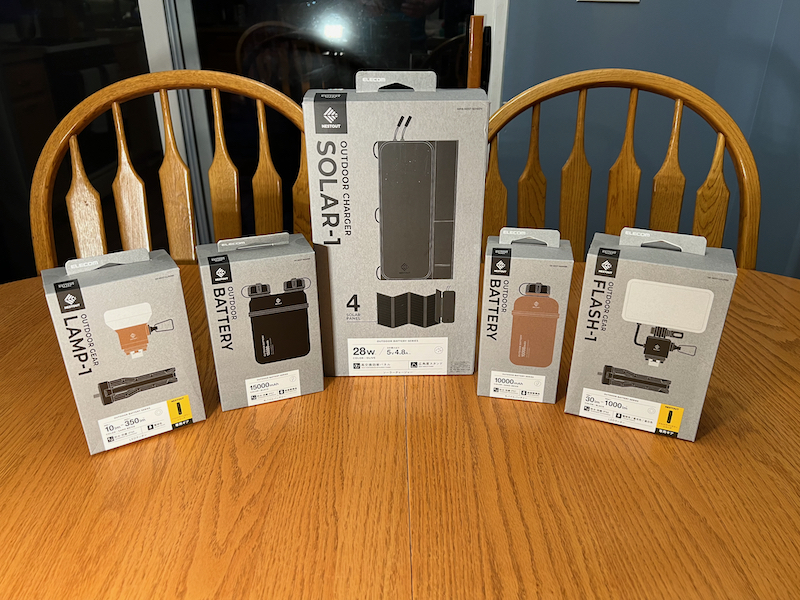
REVIEW – Portable batteries are all the rage. You can get them in a variety of sizes, shapes, and capacities from a never-ending list of vendors. What does it take to stand out in this crowded field of chargers and charging accessories? ELECOM has a solution in their NESTOUT series of outdoor gear, specifically their SOLAR-1 portable solar panel, their 10,000 mAh & 15,000 mAh batteries, and LAMP-1 and FLASH-1 lights.
What is it?
ELECOM’S NESTOUT gear includes their SOLAR-1 2-panel and 4-panel solar chargers, 10,000 and 15,000 mAh portable chargers, and two lights – a 1,000 lumen floodlight and a 350 lumen lamp.
What’s in the box?
(ELECOM sent me these items as a package for review but they are sold individually)
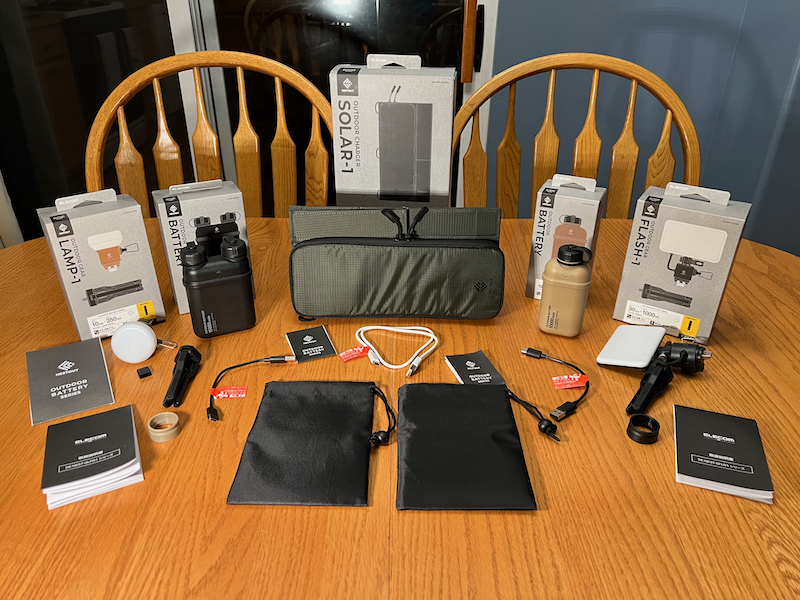
SOLAR-1
- Solar panels with integrated zippered case
- USB-A to USB-C cable
- User Guide
10,000 mAh Portable Charger
- Portable Battery
- USB-A to USB-C Cable
- User Guide
15,000 mAh Portable Charger
- Portable Battery
- USB-A to USB-C Cable
- User Guide
FLASH-1
- Light
- Collapsible Mini Tripod
- Connector Ring
- Carrying Pouch
- User Guide
LAMP-1
- Light
- Collapsible Mini Tripod
- Connector Ring
- Carrying Pouch
- User Guide
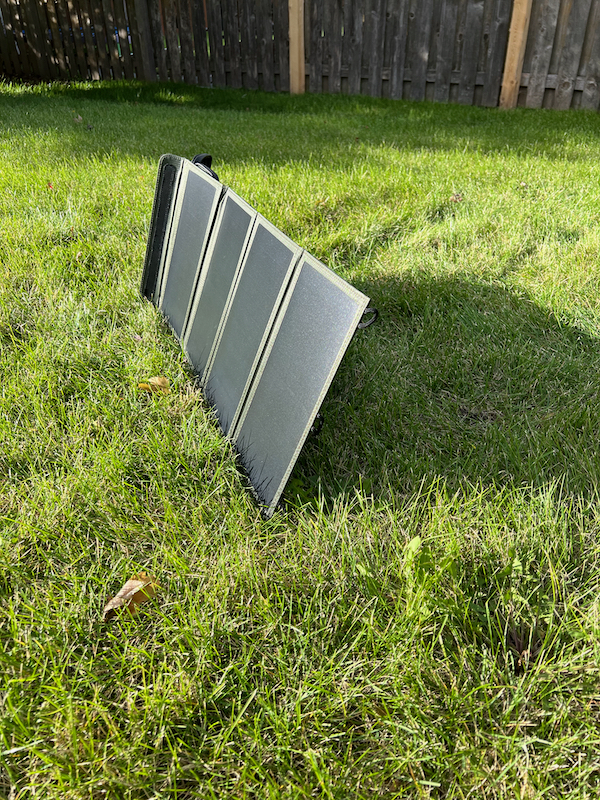
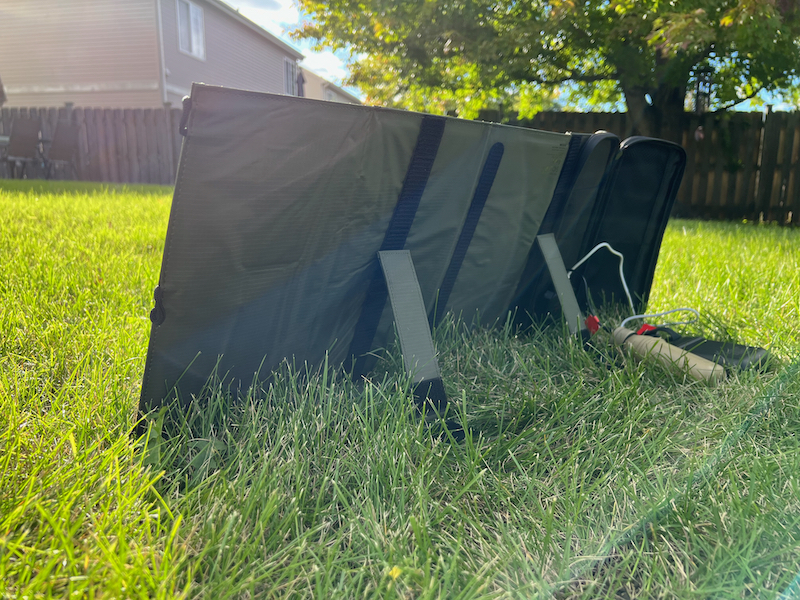
Hardware specs
SOLAR-1
- Model number: MPA-NEST-S014 series
- Electricity generation capacity: Maximum 28 W
- Electricity generation efficiency: Maximum 24%
- Port: USB-A port × 2
- USB output: Maximum total current 5 V/4.8 A, maximum current for each port 5 V/2.4A
- Operating temperature range: 0to40°C (32to104°F)
- Storage temperature range: -20to70°C (-4to158°F)
- Dimensions: When folded, Approximately 155 × 285 × 50 mm (6.1 × 11.2 × 2.0 in.)
- When unfolded, Approximately 670 × 285 × 12 mm (26.4 × 11.2 × 0.5 in.) (Excluding the thickness of the pocket)
- Weight: Approximately 765 g (27.0 oz)
10,000 mAh Portable Charger
- Model number: DE-NEST-10000A series
- Compatible Devices: iPhone or smartphones, tablet PCs, and other small electronic devices that charge using USB
- Connector type (Input): USB-C port
- Rated input voltage: 5V/9V
- Rated input current: 3A/2A
- Connector type (Output): USB-C port ×1, USB-A port ×1
- Rated output voltage: USB-C – 5V/9V, USB-A – 5V
- Rated output current: Total 20 W (USB Type-C is 3 A/2.22 A, USB-A is 2.4 A)
- Battery type: Rechargeable lithium-ion battery
- Rated battery capacity: 3.6 V 10,000 mAh
- Charging time: Approximately 2 hours, 45 minutes
- Dimensions: Approximately 61×36×126mm (2.4×1.4×5.0in.)
- Weight: Approximately 241 g (8.5 oz)
- Cycle life: 1,000 times
15,000 mAh Portable Charger
- Model number: DE-NEST-15000A series
- Compatible Devices: iPhone or smartphones, tablet PCs, and other small electronic devices that charge using USB
- Connector type (Input): USB-C port
- Rated input voltage: 5V/9V
- Rated input current: 3A/2A
- Connector type (Output): USB-C port ×1, USB-A port ×2
- Rated output voltage: USB-C – 5V/9V, USB-A – 5V
- Rated output current: Total 32 W (USB-C is 3 A/2.22 A, USB-A is 2.4 A)
- Battery type: Rechargeable lithium-ion battery
- Rated battery capacity: 3.6 V 15,000 mAh
- Charging time: Approximately 3 hours, 35 minutes
- Dimensions: Approximately 85 ×36×129mm (3.3 × 1.4 × 5.1in.)
- Weight: Approximately 364 g (12.8 oz)
- Cycle life: 1000 times
FLASH-1
- Connector Type: Custom USB-A Connector
- Lumens: 10-1,000
- Color Temperature: 2800K-6000K
- Rated Input Power: 12 W
- Compatible Devices: NESTOUT Batteries
- Weight: 135 g
LAMP-1
- Connector Type: Custom USB-A Connector
- Lumens: 10-350
- Color Temperature: 2800K-3200K
- Rated Input Power: 7.5 W
- Compatible Devices: NESTOUT Batteries
- Weight: 75 g
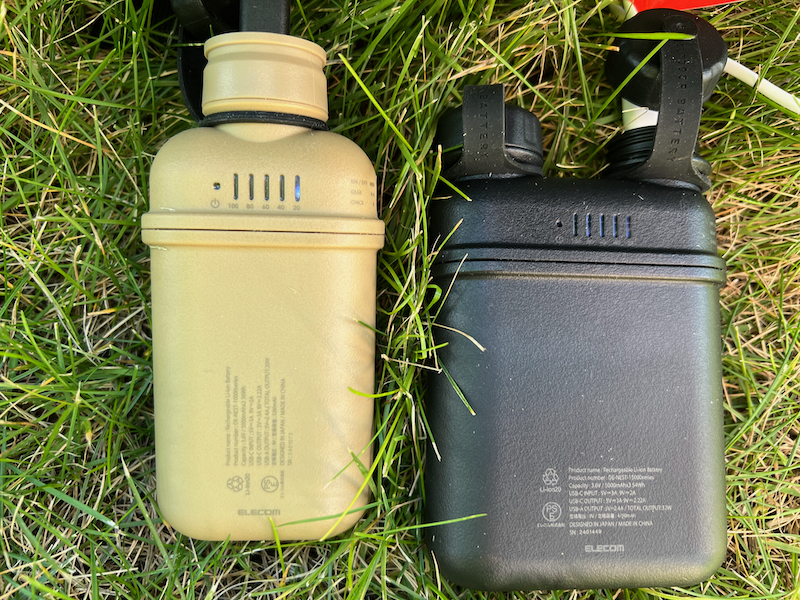
Design and features
The ELECOM NESTOUT gear is a series of products designed for outdoor use. The SOLAR-1 solar panels come in an integrated zippered pouch which unfolds to reveal the solar panels (2 or 4 panels depending on the model you purchase) on one side and a kickstand and a square block with two USB-A connectors and a current meter. The USB-A connectors come with integrated rubber caps to protect them from the elements when they’re not being used. The current meter displays the level of charging output in .1 A steps, showing the combined output of both of the USB-A connectors.
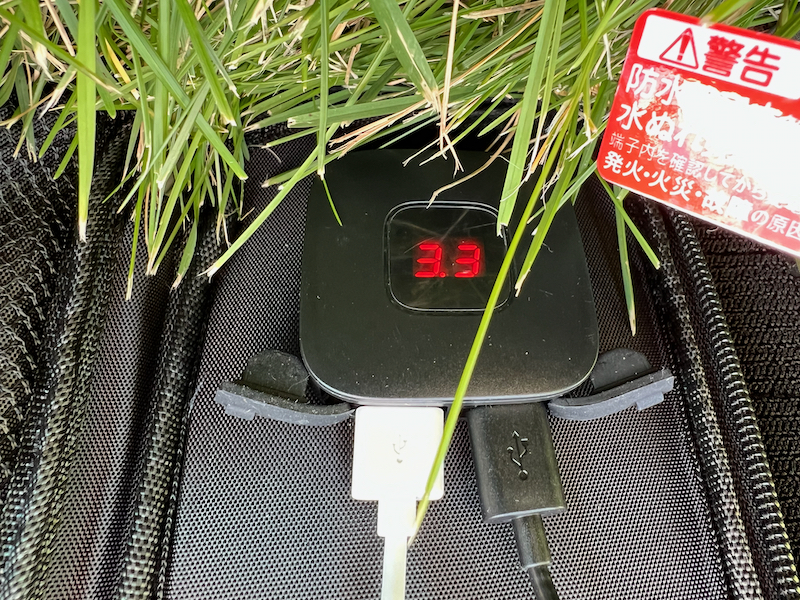
The portable chargers look like a military-style canteen, built with plastic bodies and a removable cap designed to protect the USB-A and USB-C connectors. The 10,000 mAh battery has one removable cap and one set of each output connectors; the 15,000 mAh battery has two removable caps and one USB-C and two USB-A connectors. At the bottom of each battery is a small threaded hole meant for attaching it to the mini tripod that comes with the FLASH-1 and LAMP-1 lights. The removable caps are held on by rubber straps which helps reduce the risk that they’ll get lost.
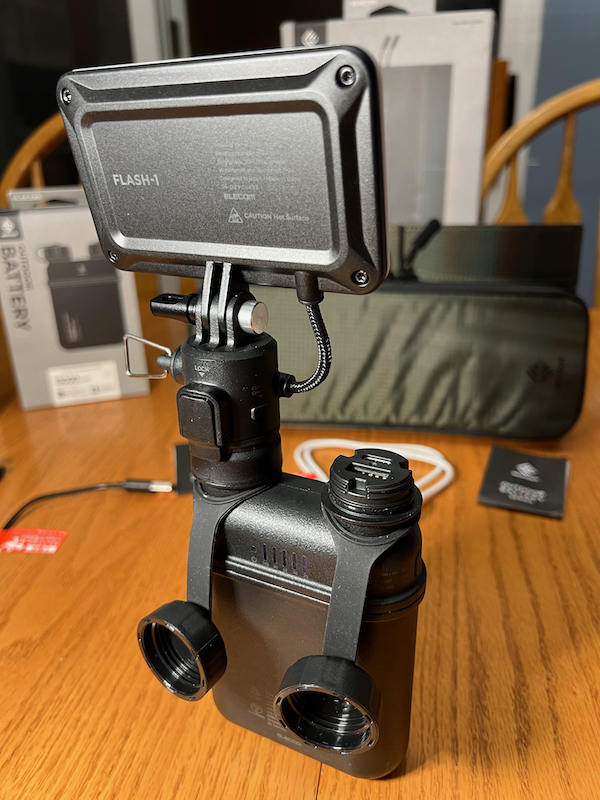
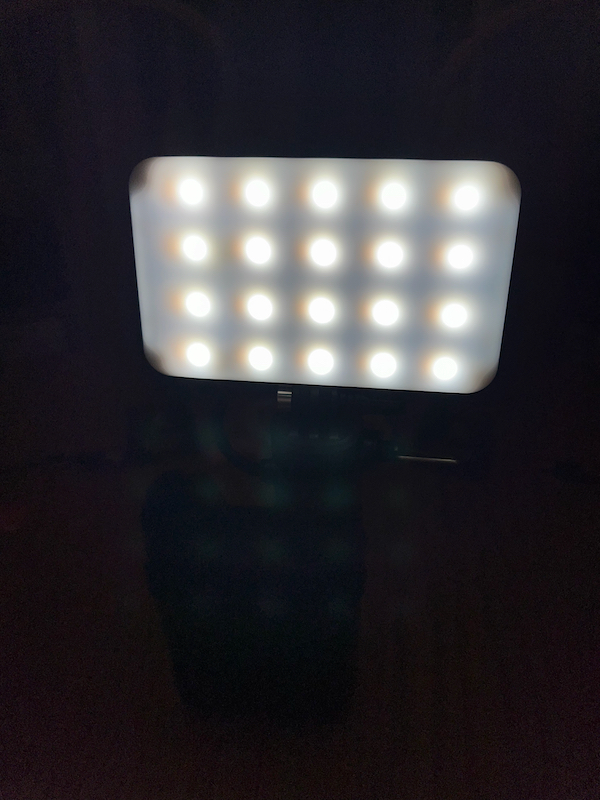
The FLASH-1 is a rectangular light with a tilt mount (which looks similar to the mounts used for GoPro cameras) that allows it to be tilted up to 180º. There is a small knob used for dimming the light, from 10 to 1,000 lumens. 10 lumens would be great as a nightlight on in your tent and 1,000 lumens is useful for reading, playing cards, cleaning up, etc. The dimming is stepless so it’s almost infinitely adjustable between 10 and 1,000 lumens to help you achieve just the right amount of light level for any activity. The USB-A connector is integrated into the body of the light and has a clip which is designed to attach to the connecting ring that comes with the light. The ring screws on to the top of the portable charger and the light clips into it, also plugging into the USB-A output of the battery.
The LAMP-1 is a round-headed light with an integrated dimmer. Everything is similar to the FLASH-1 except the head does not tilt and the brightness level goes from 10-350 lumens.
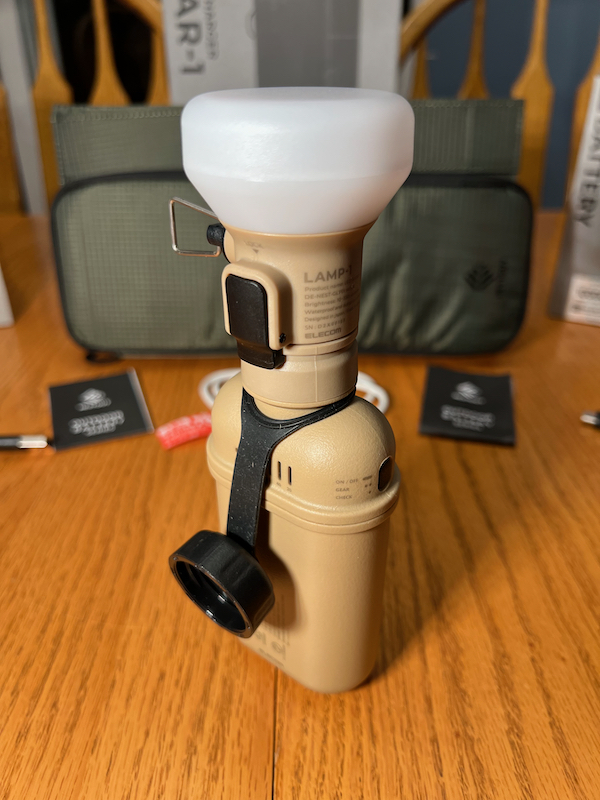
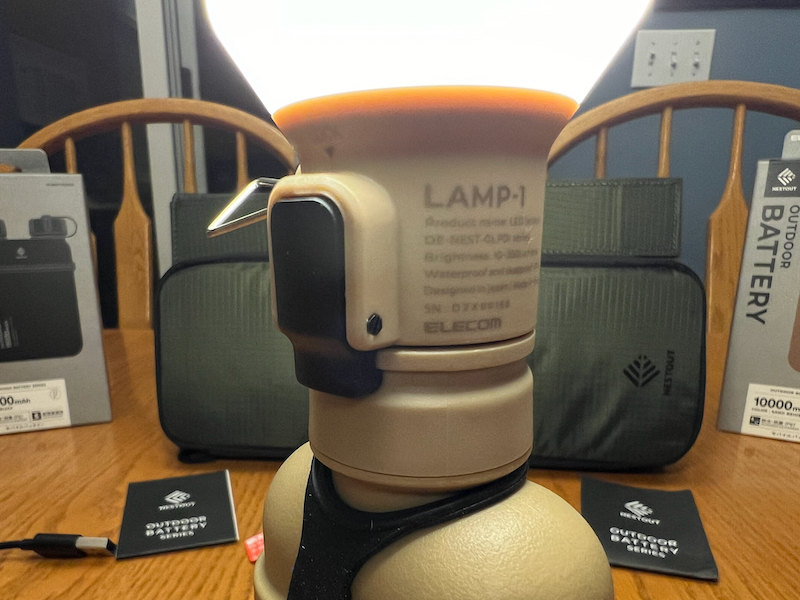
The solar panels are only available in an olive green color, the portable chargers come in beige, black or gray, and the lights are available in beige or black. The solar panels came with a USB-A to USB-C cable, which is about 23 inches long. The portable chargers come with a 7 inch USB-A to USB-C cable, which is really short in my opinion.
Despite their plastic construction, these products do not feel cheap. The plastic contributes to their light weight and as long as they’re treated well they should last a long time. They have been tested using US Military Standard MIL-STD 810G 516.7 Drop Test. I don’t know military specs very well but that at least gives you an idea of their ruggedness should you choose to research that further.
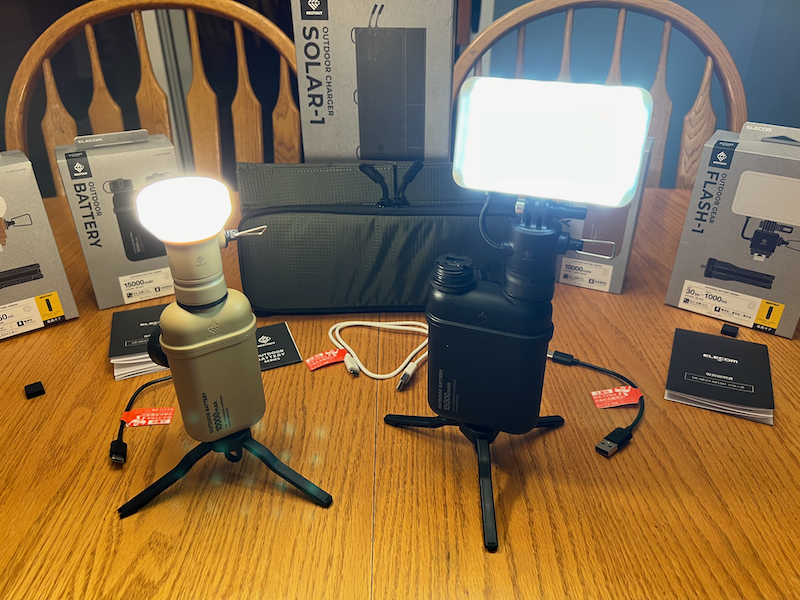
Installation and setup
For the solar panels the setup was easy. Take them out of the box, unzip the zippers, unfold the panels, set up the integrated kickstands (they’re permanently attached at one end and have hook-and-loop style attachments at the other end), and place them in direct sunlight.
The portable chargers are even easier. Simply unbox them, unscrew the cap, charge them up, and they’re ready to go. There are 5 LEDs on the back of each charger to indicate charge level. There is a sixth, smaller LED used to indicate power status.
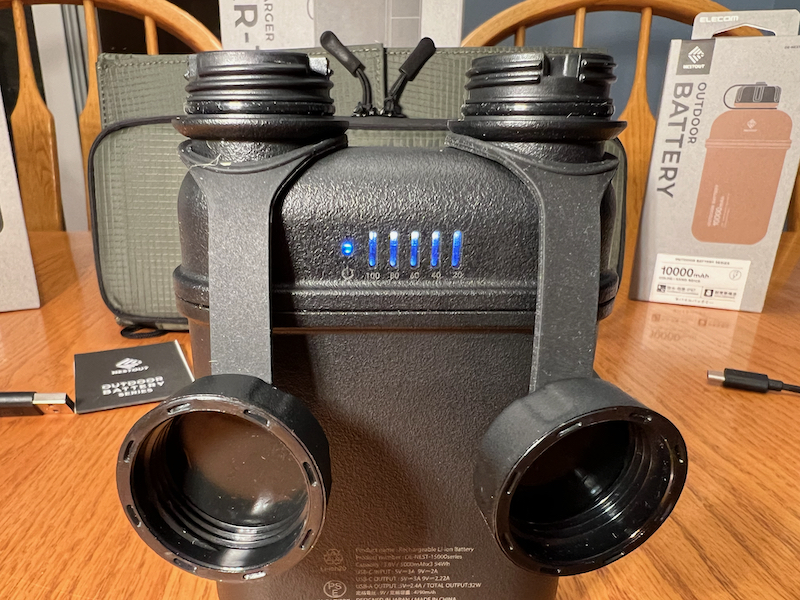
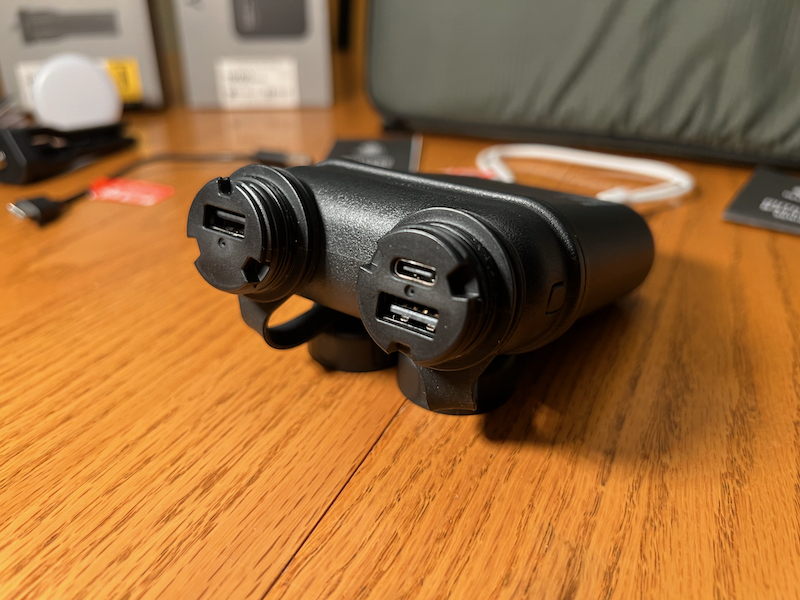
The lights are similarly easy to set up, but they have a few more parts. The connector ring has to be screwed in to the cap of one of the portable chargers, then the light has to be clipped into the connector ring, which orients the USB connector for proper use. If you want to stand up the light, screw the included mini tripod into the bottom of the portable charger and unfold the legs. There is also a plastic ring molded into the body of the mini tripod which can be used to hang the light from the roof of your tent or whatever room you have it in if you’d prefer to have the light coming from above. These are great lights for lighting up your camp site, your living room during a power outage, or your s’mores supplies in the back yard.
In Use
This whole setup was very easy to use. The manuals for all the products came in a foreign language (presumably Chinese) but I was able to figure most of it out without needing the manuals (although the pictures were helpful). ELECOM does have downloadable PDF manuals for each product that include English as well as multiple other languages. The main thing I couldn’t figure out without the manuals was how to turn on the lights. I had attached them correctly and pressed, double-pressed, and long-pressed the power button on each battery but there was no light. I finally discovered that the lights had integrated dimmer knobs; once I realized that I was able to turn them on. The lights put out plenty of light and since they’re dimmable to 10 lumens you can set them to just the right light level for just about any situation.
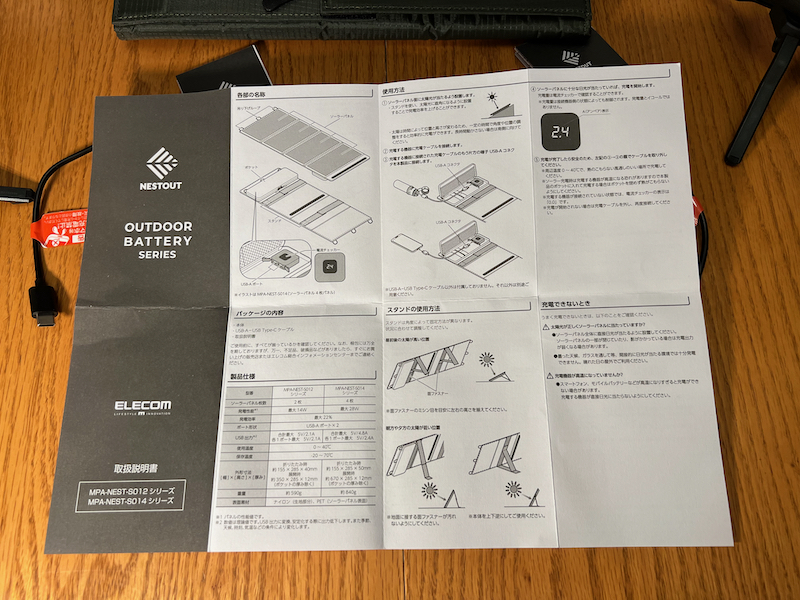
I did a charging test with the solar panels and both batteries in the late afternoon one day. I had about two hours of sunlight left so I used the first hour to charge the batteries. During this hour the meter on the back of the solar panels peaked at 3.3 A. This indicates the total amount of current going to both USB-A outputs combined. The batteries had flashing LEDs, indicating that they were charging. The 15,000 mAh battery charged the fastest, ending with four of the five LEDs lit up solid with the fifth blinking, indicating that it had between 80%-100% of charge. The smaller battery only had one LED fully lit with the second flashing. The fact that the larger battery charged faster surprised me; I would have expected the smaller battery to go faster. I’m assuming that either the charger prioritizes the device that was plugged in first or one of the outputs puts out more current than the other. I honestly don’t remember which device I plugged in first so I can’t say for sure what’s going on here.
I was surprised and a bit frustrated when I went to use the 15,000 mAh battery a little bit later and it seemed to have no power. Its LEDs indicated that it was dead even though I had just charged it up to at least 80% a few hours earlier. I charged it up again, this time with a regular USB-C charger, and it worked fine after that. I don’t know what caused this discrepancy but it’s definitely something I’ll need to keep an eye on if I plan to rely in it to have a charge.
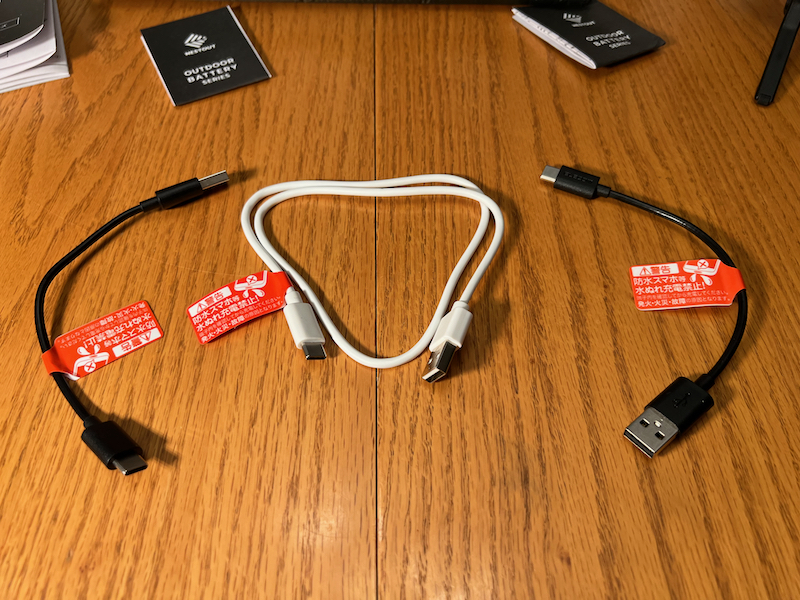
I wanted to see how much current the solar panels would put out when it was cloudy. Thankfully I didn’t have to wait very long for a few clouds to come by (or for them to leave again). When the sun was blocked the most on my testing afternoon the current output dropped to 0.2 A and even down to 0.0 A at one point. I had expected it to drop to 1 A or even 0.5 A, but I was surprised to see the output drop to 0 so quickly. I know solar panels aren’t very efficient when there are clouds but I don’t have a lot of experience with solar energy (even though I’ve had solar panels on my roof for about a year now – I haven’t tracked them very much up to this point) but this was surprising.
The portable chargers support simultaneous charging, meaning you can be charging the portable charger while charging another device. I think they should actually call this sequential charging. When you’re charging this way, the connected device will charge to full, then the portable charger will charge to full; if the connected device’s charge has dropped by this time it will finish charging, then the charging process is complete. I’m not saying this method is the wrong way to do it, but I wanted to explain it so you understand that it is not sending charge to both devices simultaneously as the term would seem to indicate. In my opinion this is probably the correct way – the idea is to get your device charged so you can use it whenever necessary, then make sure the portable charger is completely charged up as well. The term simultaneous charging can just be a little bit confusing.
I did test the water resistance of the portable chargers and they both passed. I submerged them for about 20 minutes and they both worked perfectly afterward. I did not test the water resistance of the lights but they seem to have the same level of water resistance as the batteries. The solar panels are also said to have durable, water-resistant nylon, but there is no rating given and I didn’t test their water resistance either.
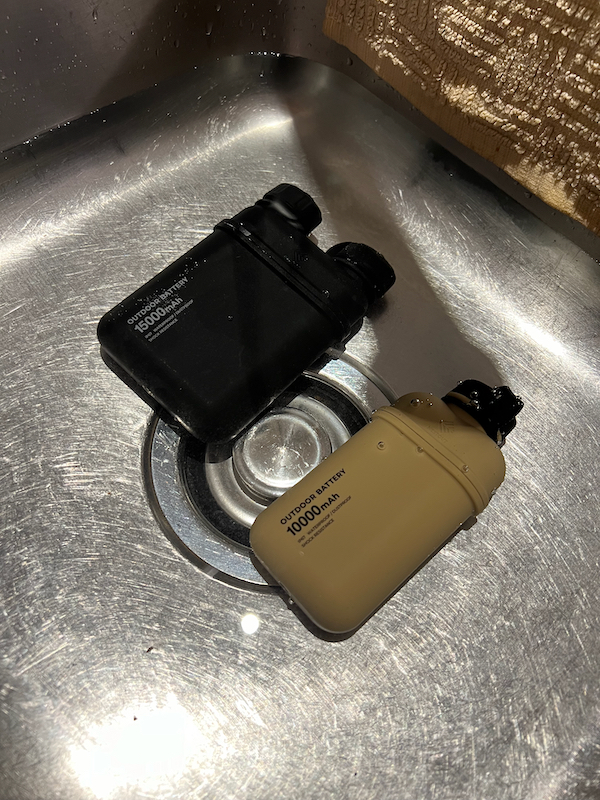
I saw in the manual for the portable chargers as well as the photos for the solar panels that there’s supposed to be a 5,000 mAh battery available but I couldn’t find it for sale or any other information about it. It could be that it’s a future product or that it was planned and canceled at some point. The photos for the solar panel that include this battery seemed to indicate (to me at least) that the battery was supposed to come with the solar panels but this was not the case.
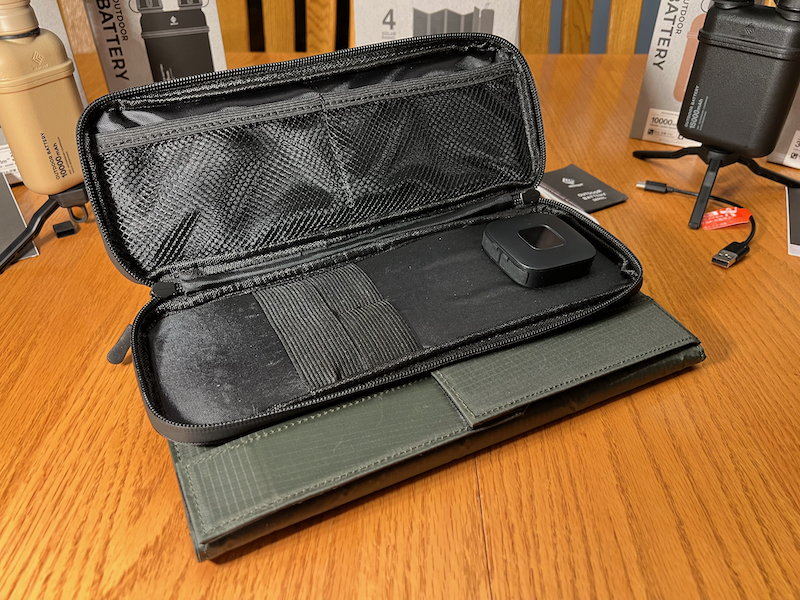
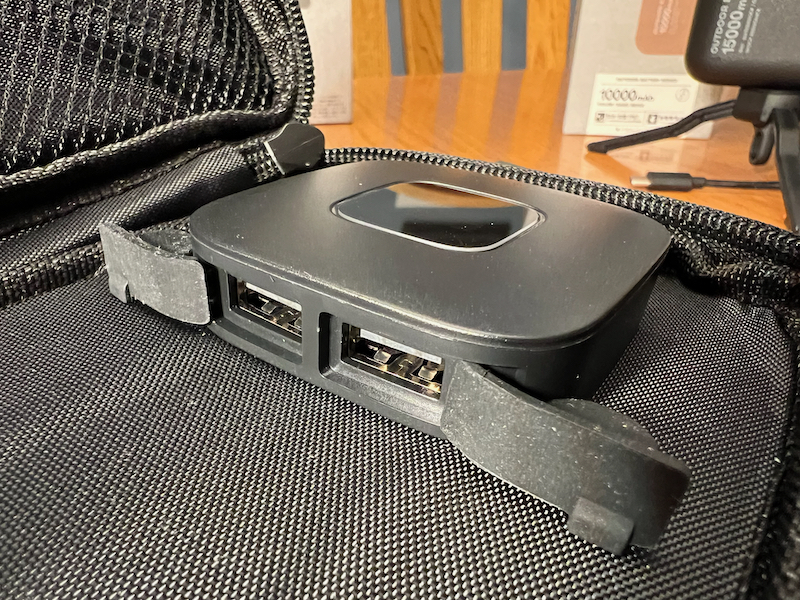
There is a lot to like about this set of gear but there are a few negatives, or at least things I would like to see in upgraded or slightly more expensive versions. First, I’d like to see a higher wattage solar panel option. 28 W is great for smaller electronics, but it would be good to have say a 50 or 100 W option.
Second, I wish the batteries had more than 20 W or 32 W output. Again, this is fine for smaller electronics, but if you’re wanting to charge a laptop, an iPad Pro, a power-hungry flashlight, or something like that, it’s going to take longer. Even still, this is much better than the 5-10 W chargers that used to come with most phones, and if you’re camping you’re probably not going to need to have a laptop (unless you just have to get some work done) or iPad (unless you need to watch some TV).
Third, I’d like to see the charging meter on the solar panel placed in a better location. As it is, the display is near the ground and upside down when the panels are propped up. If you need to tilt them very far the display is even harder to see. If this could be at the top of the back panel or somehow integrated into the front of the solar panels, that would make it a lot easier to see. I had to resort to using my phone to take a picture of the display, then rotate it 180º to read it right side up.
What I like
- Interchangeable charger and light system
- Affordable
- Well-integrated system
What I’d change
- Higher wattage output from portable chargers
- Higher wattage output from solar panels (or an upgraded model as an option)
- Find a better location for the charging meter
Final thoughts
Overall this is a great set of portable devices for charging and recharging your devices off the grid, and lighting up your surroundings while camping, during a power outage, or just having fun after dark in the backyard. Despite a few small shortcomings this is a useful range of products.
Price: LAMP-1 – $37.99, FLASH-1 – $39.99, 10,000 mAh Charger – $49.99, 15,000 mAh Charger – $59.99, Solar Panel (4-panel) – $98.99
Where to buy: Amazon or elecomusa.com
Source: The sample for this review was provided by elecomusa.com. For more information visit their site.



